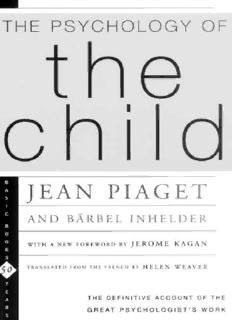
The Psychology Of The Child PDF
Preview The Psychology Of The Child
THE PSYCHOLOGY OF THE CHILD THE PSYCHOLOGY OF THE CHILD Jean Piaget AND BarbelInhelder WithaNew Foreword by JEROME KAGAN Translated from the French by HELEN WEAVER CONTENTS Foreword to the 2000 Edition ix Preface xv Introduction xvii I THE SENSORIMOTOR LEVEL 3 1. Sensori-niotor Intelligence 4 1. Stimulus-Response and Assimilation 2. Stage I 3. Stage 2 4. Stage 3 5. Stages 4 and 5 6. Stage 6 II. The Construction of Reality 13 1. The Permanent Object 2. Space and Time 3. Causality III. The Cognitive Aspect of Sensorimotor Reactions 19 IV. The Affective Aspect of Sensorimotor Reactions 21 1. The Initial Adualism 2. Intermediary Reactions 3. "Object" Relations 2 THE DEVELOPMENT OF PERCEPTION 28 1. Perceptual Constancies and Perceptual Causality 29 1. Constancy of Form 2. Constancy of Size 3. The Permanent Object and Perception 4. Perceptual Causality II. Field Effects 35 III. The Perceptual Activities 39 IV. Perceptions, Concepts, and Operations 43 1. Methods 2. Projective Concepts and Perceptions 3. Perceptual Constancies and Operatory Conservations 4. Situation 4 5. Conclusion 3 THE SEMIOTIC OR SYMBOLIC FUNCTION 51 1. The Semiotic Function and Imitation 52 1. The Appearance of the Semiotic Function 2. The Role of Imitation 3. Symbols and Signs II. Symbolic Play 57 III. Drawing 63 IV. Mental Images 68 1. The Problems Raised by the Image 2. Two Types of Images 3. Copy Images 4. Kinetic and Transformational Images 5. Images and Operations V. Memory and the Structure of Image-Memories 80 VI. Language 84 1. Evolution 2. Language and Thought 3. Language and Logic 4. Language and Operations 5. Conclusion 4 THE "CONCRETE" OPERATIONS OF THOUGHT AND INTERPERSONAL RELATIONS 92 1. The Three Levels in the Transition from Action to Operation 93 II. The Genesis of the "Concrete" Operations 96 1. Notions of Conservation 2. The Concrete Operations 3. Seriation 4. Classification 5. Number 6. Space 7. Time and Speed III. Representation of the Universe: Causality and Chance 109 IV. Social and Affective Interactions 114 1. Evolution 2. The Problem 3. Socialization V. Moral Feelings and Judgments 122 1. The Genesis of Duty 2. Heteronomy 3. Moral Realism 4. Autonomy VI. Conclusion 128 5 THE PREADOLESCENT AND THE PROPOSITIONAL OPERATIONS 130 1. Formal Thought and the Combinatorial System 132 1. The Combinatorial System 2. Combinations of Objects 3. Propositional Combinations II. The Two Reversibilities 136 III. The Formal Operatory Schemes 140 1. Proportions 2. Double Systems of Reference 3. Hydrostatic Equilibrium 4. Notions of Probability IV. The Induction of Laws and the Dissociation of Factors 145 1. Elasticity 2. The Pendulum V. The Affective Transformations 149 Conclusion: FACTORS IN MENTAL DEVELOPMENT 152 Bibliography 161 Index 163
Description: